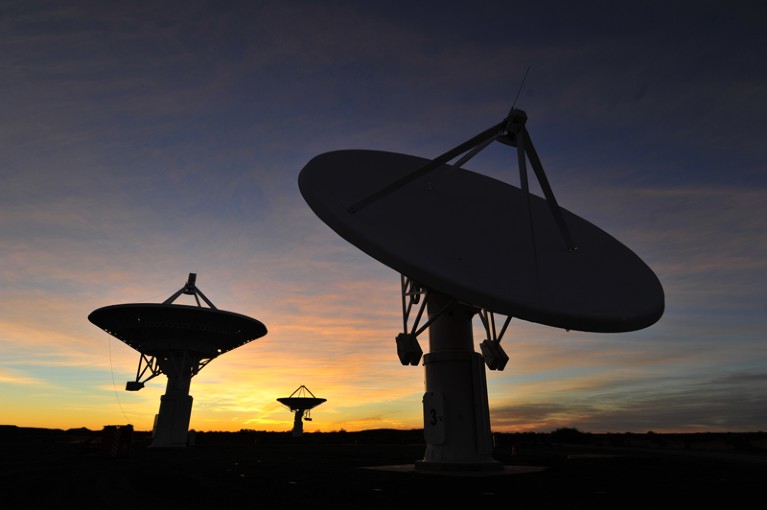
South Africa’s KAT-7 radio telescope at the site of the Square Kilometre Array in Karoo in the Northern Cape province.Credit: Alexander Joe/AFP/Getty
The Square Kilometre Array (SKA) Observatory has been more than 25 years in the planning and design, but finally launched earlier this month with the first meeting of its governing council. Construction of what will be the world’s largest radio telescope will start this summer, after an international treaty governing its membership and operations came into force in January.
The SKA will comprise around 2,000 parabolic dish-shaped radio receivers and up to one million antennas. These will be sited in South Africa and Australia, and there are plans to expand into eight other African countries, including Ghana, Kenya and Madagascar. In total, the array will have a receiving area of well over one square kilometre — hence the telescope’s name — providing an unprecedented view of the southern skies.
In addition to Australia and South Africa, Italy, the Netherlands, Portugal and the United Kingdom have ratified the treaty in their parliaments. And Canada, China, France, Germany, India, Spain, Sweden and Switzerland are in the process of joining. At a time when countries often seem inward-looking, the SKA’s successful creation is a win for north–south and east–west cooperation, having pulled together more than 1,000 scientists and over 500 engineers from around the world.
But for the SKA to be genuinely global and inclusive, the SKA Observatory — the intergovernmental organization formed to oversee the project — must move quickly to ensure that this powerful instrument is also open to researchers from non-member states. The telescope is poised to help answer some of science’s biggest questions, including the nature of dark matter, how galaxies form and whether humans are alone in the Universe. An instrument of this size and sensitivity will be able to detect faint radio signals from the early Universe in greater detail than currently available telescopes can. If the SKA is to realize its full potential, it must give as many of the world’s astronomers as possible an opportunity to participate.
Split decision
After Australia and South Africa made competing bids to host the telescope, a decision was made in 2012 to co-locate the physical infrastructure, splitting it between the Karoo region of South Africa’s Northern Cape and Murchison in Western Australia. This is being built in phases. The first phase, which is already under way, will cost just under 2 billion (US$2.4 billion) to build and operate, and will take a decade to complete, according to SKA director-general Philip Diamond. It will form about 10% of the final design, comprising nearly 200 dishes in South Africa and more than 130,000 antennas in Australia, with each site focusing on different parts of the radio spectrum.
World’s largest radio telescope needs to hit US$1-billion target
But the journey to this point has not been smooth and the SKA has struggled to raise funds. Diamond told Nature last year that if the main funding target isn’t reached, a scaled-back design costing 691 million will be implemented. One of the reasons why the creation of an international treaty to govern the SKA is so important is that it creates a legally binding obligation for members to pay what they have promised.
So far, the SKA’s financial position has not been made public. But a treaty ratified by parliaments also creates a mechanism for legislatures to demand accountability from governments, including disclosing what they are contributing. If this can happen, it will make the costs and terms of membership more transparent.
What the governing council should do next is introduce an ‘open skies’ policy, whereby a sizeable percentage of the telescope’s observing time is set aside for allocation to scientists according to the strength of their research proposal, rather than where they are in the world. With a few exceptions, national and international observatories offer anything between 35% and 90% of observing time in this way. Now that the SKA’s construction is formally under way, and as more countries join the observatory, it should be possible to realize a principle that has been at the heart of radio astronomy since the field’s inception, but that has not, so far, been a part of the SKA’s rules.
Setting records
Even though the SKA has only just been formally launched, it has already yielded some impressive results. In South Africa, MeerKAT, a 64-dish precursor telescope to the SKA that is already up and running, has taken the most detailed radio image yet of the centre of our Galaxy. And last year, Australia’s SKA pathfinder telescope (ASKAP), which was designed to showcase Australia’s readiness to host the SKA, created a new atlas of the Universe, mapping a record-breaking 3 million galaxies in 300 hours.
The SKA’s development has benefited the field in other ways, too. The number of radio astronomers working in South Africa has increased from fewer than 10 in 2005 to more than 200 today. And the SKA’s future expansion into more of Africa’s countries will further boost the continent’s astronomy community. Ghana already has its own radio telescope, and more are being planned across the continent.
The SKA project needs more members if it is to achieve its full potential, and it must formally commit a meaningful proportion of its observing time to open-skies work to avoid the risk of radio astronomy becoming exclusive to a handful of nations. By instituting an open-skies convention, the SKA Observatory will both improve the quality of the telescope’s science and aid the development of astronomy communities around the world.

 World’s largest radio telescope needs to hit US$1-billion target
World’s largest radio telescope needs to hit US$1-billion target
 Super-sensitive telescope gets global governing body
Super-sensitive telescope gets global governing body
 South Africa celebrates completion of gigantic, super-sensitive telescope
South Africa celebrates completion of gigantic, super-sensitive telescope
 Giant radio telescope scaled back to contain costs
Giant radio telescope scaled back to contain costs







